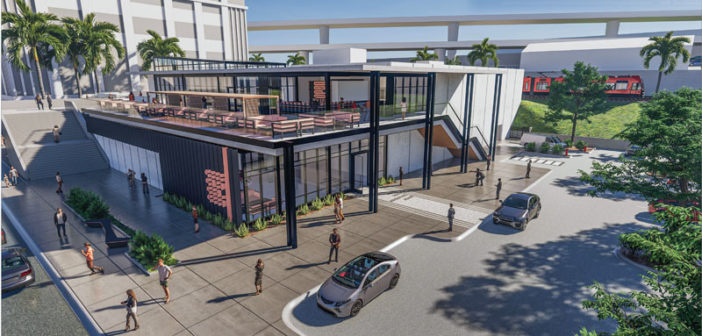LOS ANGELES—The founders of Stay Open, which bills itself as a “Sleep as a Service” platform, hope to democratize how and where people sleep with affordable tech-forward and socially engaging pod and private-room hotels and residences.
The brand’s hotels and residences consist of private modular rooms each with four to eight private sleeping pods, high-end shared restrooms, large common areas for work or play, F&B outlets and locally inspired amenities. Private rooms and family rooms with the option of private bathrooms are also available.
“Although I don’t like the word hostel, we are basically creating fancy hostels and eliminating the pain points that typically have been associated with hostels,” said Steve Shpilsky, CEO, who founded Stay Open with Andrew Swerdloff and Alex Morrise. “Why do people need to pay for a whole room that is subpar when they only use it six-to-eight hours a night? Why don’t we just charge people for the bed? We make the bed better, and that is when we started developing it using pods to provide for light and sound installation and some element of privacy while still allowing for the affordable component.”
Everything at the property is done with a mindset of flexibility. “The nice thing is, generally speaking, none of the rooms that we build have a private restroom,” he said. “Some do, but most of our rooms, the average pod room, have eight pods per room. Most pods are mobile; you can pull them out. They are not permanent fixtures. It is not like cabinetry built into the wall. We can convert any pod room into a private room within a matter of minutes. We get the pods out and then put in a bed.”
The flexibility allows the style of rooms to change if needs or the market change. “If we see that a lot of people would rather have a private room and pay $200 a night for that room versus a shared room in a certain location, we could flexibly adjust for that, which isn’t typical in a regular hotel or a regular property—you are usually stuck with what you have built,” said Shpilsky.
The pods were inspired by those that are popular in Asia, but only as a starting point. “We are making them larger than you would typically see in a Japanese or Asian pod hotel,” he said. “We are really putting a lot of time and effort into the redesign of our pods. We have an existing pod version we worked on with a partner out of New Zealand. We are redesigning the physical aesthetic of the pod and some of the functions inside. We don’t feel like you are going into a coffin. We really want it to feel open and spacious. The thing is when you go inside these pods and you open up the door, they feel much bigger than what could ever be represented in an image. They feel pretty cozy. We are embracing different design elements, curvature, lighting to give people this almost womb-like, comforting feel. It is actually a point of relaxation versus something that feels claustrophobic.”
Shpilsky also said that the company wants to make sure it creates a community for its guests because connecting them before they even arrive at the property will make for a better experience for all. “We are doing this at a time when—subject to when it is safe to do so—people are really going to be yearning for connection, interaction and being around each other in a way that we haven’t been around each other the past year. We are pulling people out of their screens and into real life; we’re inverting the social network from digital to real-life experiences.”
Given the shared environment of pod rooms, guests will be more likely to want to connect with others. “When you ask people about the best part of staying in a shared environment, they will say the people they met and the great times they had with them,” he said. “We want to use technology ahead of time to connect those people. We want to engage people even before they travel. Our app development is gamifying the onboarding process of the individual. The way that we are setting up our profile is very unique; it is not like you just write in what you are interested in. We are using icons; we are using imagery to make it fun. Each image has a certain datapoint and we are using that to shape a profile of an individual to help match him or her with a better potential roommate at their stay.”
He continued, “Why should the interaction be random in a lobby when you come across someone that you may become a friend for life, or you may have a great adventure with? That should start happening even before you arrive at the property—understanding who is staying at the property and who has stayed there in the past to help drive your decision of where you want to stay.”
Beyond connecting guests before they arrive, the company plans to use technology to streamline operations. “We are improving some of the operational inefficiencies that exist in hospitality right now—everything from how hotels and co-living properties are designed, which is still done in an archaic fashion going back and forth between architects and financial underwriters, with very little use of data science or other elements that are now readily available,” said Shpilsky. “They just need to be aggregated in a certain way and processed so that decisions can be made quicker and better—everything from the design process to the user experience.”
They are also leveraging data science when the decision is made how to set up a property. “We come in with a certain set of assumptions,” said Shpilsky. “The technology that my cofounder and CTO Alex [Morrise] is building is actually trying to use data science to drive those initial decisions. This way we can look at whether a market demands more split-up, private rooms because that is going to be the highest revenue generator, or more private rooms where a couple, a family or an individual want to stay in a fun social environment, but still wants their private room. We are trying to instill some data science behind these decisions and developing technology that with the push of a button spits out an optimal layout based on the parameters of the property. There are some walls you can move and there are some walls you can’t, so we look at those as parameters, and we also look at the parameters of the hyper-local market. We look at the common areas and how big they should be.”
Shpilsky said that while the company will look at former hotels for conversions, it is not limiting the places where Stay Open can operate. “We have a couple of projects in Hollywood, CA, that are conversions of motels, so we still look at traditional hotels for conversion, but why limit ourselves to a traditional hotel when we are creating a shared accommodations project with modular pods that can shift around?” he said. “We said, ‘Why do we need to be stuck with only available hotels for sale or for lease?’ Even pre-COVID, there was a bunch of retail space that was becoming available due to the changing dynamics of retail. The office market was changing, and some of that product became obsolete and available.”
The company’s inaugural project is converting a former rental car facility near the San Diego airport into a 240-bed hotel. “There is a little heavier lift to the conversion where there is an existing first floor and we are actually adding a second floor to that property,” he said. “It is a little more than we would typically do, but we are doing it in partnership with the Port of San Diego and California Coastal Commission, so we are working with two government bodies to help bring affordable accommodations along California’s coast.”
While the company owns and is developing the San Diego property, it doesn’t plan on owning any others. “We just want to come in and manage and operate empty space on behalf of ownership,” said Shpilsky. “That is going to help us scale and grow the business model because buying a property is not an efficient use of our capital long term. HB


